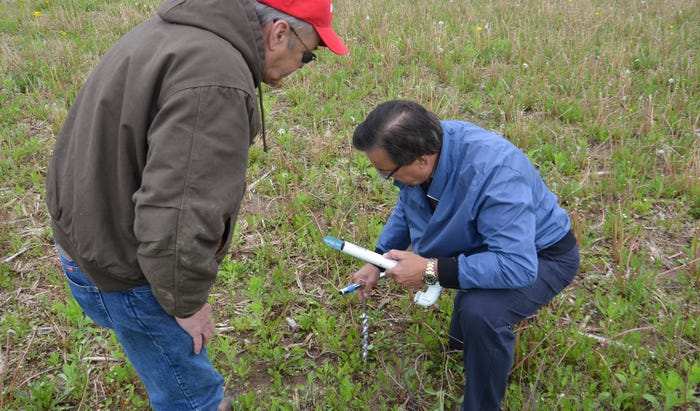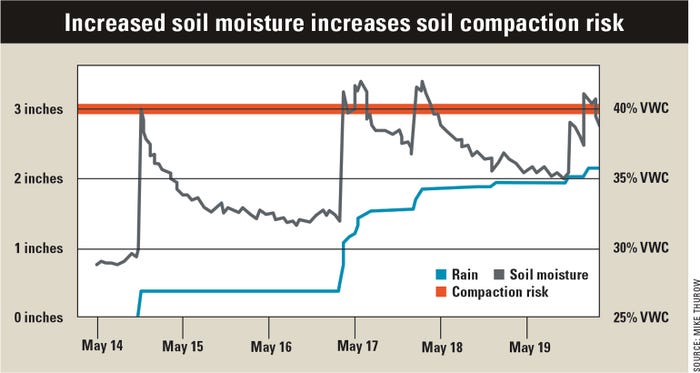
You wake up and find it rained a half-inch at the home base where you intended to sidedress corn today. So, you check a weather app on your phone for results from a weather station in your field 6 miles to the north. No rain fell there, and soil moisture is at a level below where you would cause soil compaction. In 60 seconds, you make a management decision and use the same phone to call your employee so he can begin moving equipment north.
Is it a pipe dream? No, it’s reality. You can do it today using existing weather equipment. Mike Thurow, head of Spectrum Technologies, says his company is offering a complete lineup, including some new offerings for 2021, which allow you to add lower-cost weather stations to report rainfall, temperature and soil moisture to your phone in real time, using an app.
“Rainfall is variable, even within a field, and especially if your fields are spread out,” Thurow says. “We’re tending to see more frequent and more intense rain events today, and their coverage is often not very uniform. By having actual weather stations in several fields, you can know instantly where it rained and where it didn’t, and what the soil moisture reading is in each field. If you can rearrange your work order so you work in fields where the soil isn’t near field capacity for wetness, you’re less likely to cause soil compaction, which can reduce yield potential.”
Beta test volunteers
Thurow sought volunteers in 2020 to test the new weather equipment with soil moisture sensors. John and Holly Spangler installed one in a field on their farm in west-central Illinois, near Marietta. Thurow also installed one on Ryan and Jim Facemire’s farm near Edinburgh, Ind. The Facemires cooperate with Farm Progress in the Soybean Watch project.
 INSTALL MOISTURE SENSOR: Jim Facemire (left) watches as Mike Thurow installs a moisture meter for the weather station Facemire helped test on his farm near Edinburgh, Ind.
INSTALL MOISTURE SENSOR: Jim Facemire (left) watches as Mike Thurow installs a moisture meter for the weather station Facemire helped test on his farm near Edinburgh, Ind.

The soil types in the two fields were very different. Spangler’s field is a silty clay loam, with higher water-holding capacity and a tendency to be wet in the spring. Facemire’s field is loam over gravel at 3 feet and is irrigated.
“When each farm got a rain in late May or early June, the soil moisture level would spike, then it would settle back in a day or so to a level higher than before the rain,” Thurow reports. “The difference between the two sites tended to be striking, even when they were both getting rain. The saturation percentage on the field in Illinois was always higher, sometimes in the mid-30s. It was lower on the Indiana field, often in the low 20s.”
 SOIL MOISTURE LAGS RAINFALL: Mike Thurow shares this graph collected by one of the weather monitoring stations in 2020. Note that after a rain, soil moisture increases. VWC stands for volumetric water content. Thurow placed the red “soil compaction” line at 40% to indicate where he believes field activity would be more likely to cause soil compaction.
SOIL MOISTURE LAGS RAINFALL: Mike Thurow shares this graph collected by one of the weather monitoring stations in 2020. Note that after a rain, soil moisture increases. VWC stands for volumetric water content. Thurow placed the red “soil compaction” line at 40% to indicate where he believes field activity would be more likely to cause soil compaction.

What did the farmers say? They appreciated having the information but noted there was a learning curve. John Spangler said it took a while to get familiar with what various readings meant on the app, even though they were well-explained. Jim Facemire said he would have learned more if he had moved the soil sensor farther into the field, where irrigation water hit.
The plan is to adjust soil moisture sensor placement and follow weather information reported on the app more closely this season. Learn more about these units at specmeters.com.
The unit installed on both the Spangler and Facemire farms is the Watch Dog 3000 wireless remote weather station. Once on the website, click on “weather stations” on the top bar and select the model 3000 from the dropdown menu to learn more. List price is $1,495 plus $49 set-up fee. You will also need the $379 annual subscription fee for the app to relay information to your phone, and to store data from the field long term. The SM 100 soil moisture meter with 20-foot cable is an additional $105. You can purchase a tripod stand as shown here for $107 or mount the weather station on your own post or stake.
About the Author(s)
You May Also Like






